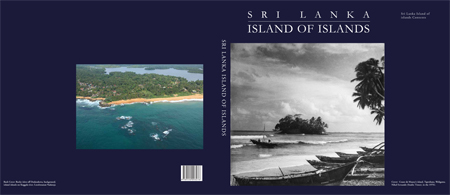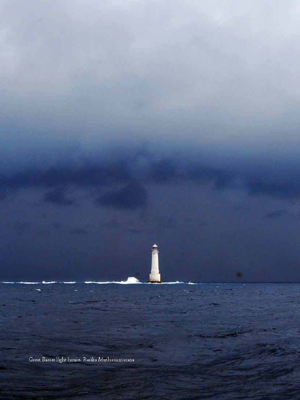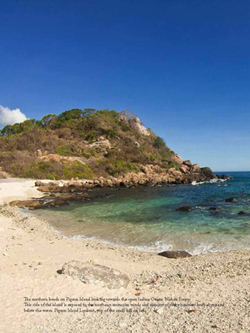A little known heritage
“It lies all alone, far from the mainland, where nobody would think of finding a reef in the middle of the deep ocean. Throughout history, it has brought grief to many people, as well as to ships that sailed to their final destiny.”
The reference is to the Basses Ridge, a long, narrow, submerged reef running parallel to the southern coast of Sri Lanka, which in two places rises above sea level as rocky islets. On these sit two legendary lighthouses – the Great Basses and Little Basses about which many tales have been told. Rasika Muthucumarana charts how they came by their somewhat treacherous reputation and indeed the marvels of the lighthouses’ very construction in one of his contributions to the new book released by the National Trust of Sri Lanka.
 The Great Basses and Little Basses cannot be seen from land and it is such little explored terrain that the coffee table book ‘Sri Lanka-Island of Islands’ ventures to tread. The book is another in the Trust’s publications to foster public awareness of the tangible and intangible cultural heritage of this country. The choice of subject is inspired – not many are aware that there are as many as 100 islands and islets off the coastline of Sri Lanka and the hope is that the book will propel greater research into them.
The Great Basses and Little Basses cannot be seen from land and it is such little explored terrain that the coffee table book ‘Sri Lanka-Island of Islands’ ventures to tread. The book is another in the Trust’s publications to foster public awareness of the tangible and intangible cultural heritage of this country. The choice of subject is inspired – not many are aware that there are as many as 100 islands and islets off the coastline of Sri Lanka and the hope is that the book will propel greater research into them.
Compiled by former diplomat Sarala Fernando whose abiding love for the country is clearly seen in her diligent research and labour that has produced many books on Sri Lanka over the years, she was assisted in this effort by the editorial team of Somasiri Devendra and Stefan D’ Silva with Dr Malik Fernando as the scientific consultant. Sarala states in her introduction that they pondered over which islands and islets to focus on over all of two years. It must have been a difficult exercise. Included are many of the well known islands like Mannar and Kalpitiya, islets like Seenigama and Werallaiya, even if somewhat disappointingly Taprobane (Count de Mauny’s) island in the Weligama bay does not figure save for Nihal Fernando’s black and white photograph on the book cover.
 With climate change posing a huge threat to the fragile eco-systems of these islands, there is a need for a better understanding of their very distinct characteristics, hence the book’s publication is timely. Sarala in her previous books drew on a panel of professionals and experts in different fields and this time too, it is a varied selection of architects, historians, Buddhist monks and botanists who have contributed and given the calibre of photographers chosen, the images too are arresting – sheer pleasure to linger over.
With climate change posing a huge threat to the fragile eco-systems of these islands, there is a need for a better understanding of their very distinct characteristics, hence the book’s publication is timely. Sarala in her previous books drew on a panel of professionals and experts in different fields and this time too, it is a varied selection of architects, historians, Buddhist monks and botanists who have contributed and given the calibre of photographers chosen, the images too are arresting – sheer pleasure to linger over.
The contributors are Shereen Amendra, Maneshka Borham, George Cooke, Somasiri Devendra, Shravasti Dhammika, Sarath Ekanayaka, Sarala herself, Hema Goonatilake, IUCN Sri Lanka, Thangamuthu Jayasingam, Sunela Jayewardene, T. Mathiventhan, Rasika Muthucumarana, Vasantha Pahalawattarachi, Nishan Perera and Christopher Silva. The images were provided by Stefan D’Silva, Luxshmanan Nadaraja, Sur. Rear Admiral, Lalith Ekanayake, Studio Times and Sampath de A. Goonatilake.
Part 1 of the book looks at the Offshore Islands and this is a fascinating mix for among those historically well known, are Kachchativu, for instance which George Cooke records both this small nation and giant neighbour India laid claim to and the Adam’s Bridge islands that figure in ancient chronicles.
Sunela Jayewardene’s standout essay on ‘Yonder Island’ Neduntivu (Delft) paints with tender affinity the arid sandy island off the Northern coast – evoking its people, their legends, their lifestyle, their fierce independence ‘a people marching to a different drum’, the archaeological ruins, abundant wildlife, famed ponies and feral cow population.
Like Neduntivu, Nagadipa has been much written about and Hema Goonatilake in her account of this, the second most important of the 16 sacred Buddhist sites in the island (solosmasthana) traces its religious, historical and literary significance. Heading south, Rasika Muthucumarana documents Parawi Duwa, Galgediyana and Seenigama. Other essays reflect the coastal Catholics’ devotion to St. Anthony, the patron saint of fishermen.
Sober Island – a name that resonates with the World War era is captured in a brief photo essay by Somasiri Devendra and Stefan D’ Silva. There are two Sober Islands, the Great and the Little that stand sentinel at the entrance to the Inner Harbour of Trincomalee. “Strategically positioned…. it was a proper ‘stone frigate’ used for defence, not attack. They last spoke in anger during the Easter Sunday raid, 1942”, Devendra notes, detailing that after the Second World War ended, it was occupied by the Royal Navy until 1957 when it was handed over to the Ceylon Navy, and is now overtaken by the wilderness.
 Marine biologist Nishan Perera is in familiar seas writing of Pigeon Island; located off the Nilaveli coast its very beauty and popularity has become its greatest threat. His pictures capture both its coral sand beaches, turquoise waters and underwater treasures.
Marine biologist Nishan Perera is in familiar seas writing of Pigeon Island; located off the Nilaveli coast its very beauty and popularity has become its greatest threat. His pictures capture both its coral sand beaches, turquoise waters and underwater treasures.
Going off the beaten track, Maneshka Borham explores the sparsely populated island of Baththalangunduwa, five sq.km in extent, off the Dutch Bay in Kalpitiya. Reached via a three-hour ferry ride from Kalpitiya, it has become a popular destination for campers. Yet for all its lonely appeal, rising sea levels and erosion threaten its existence as a fishing village as villagers continue to migrate to the mainland.
Part 2 of the book moves to the Inland Islands and no less intriguing are these accounts. Christopher Silva takes the reader on a journey down the Mahaweli to Kalinga Nuwara, a beautiful conch-shaped island, 12 km south of Polonnaruwa and three km east of the ancient Veddah village of Yakkure. Part of the Wasgamuwa National Park, it got its name from the Kalinga dynasty of India. Historians and archaeologists like R.L. Brohier and H.C.P. Bell have documented it; Brohier believed it was King Parakrama Bahu’s shipbuilding yard and Bell that it was a monastic centre. Kalinga Nuwara is now home to the creatures of the jungle, Silva writes and access is restricted by the Departments of Wildlife and Archaeology.
Sarath Ekanayake looks at the flora of the better known Maduganga islands, home to some 303 species of plants belonging to 95 families while Somasiri Devendra and Stefan D’Silva in another photo essay on Maduganga capture ‘Life on the River’. In Polgasduwa, Bhante S.Dhammika traces how this little island on the Ratgama Lake where Ven Nyanatiloka (the German who became a Buddhist monk)set up an island hermitage which would gain international fame –candidates for monastic life came from Burma, Thailand, Cambodia, and a few from Japan and the US…”.
Other chapters include an extract from an IUCN report on the conservation and biodiversity of the islands and lagoons of Northern Sri Lanka; Shireen Amendra’s nostalgic recollections of Paradise island, Bentota, Vasantha Pahalawattarachi’s account of Crow Island and T. Jayasingam’s and T.Mathiventhan’s Islets of Batticaloa, all packed with knowledge and local lore, which unfortunately space does not permit exploring here. If there is an unevenness in the writing as happens with multiple contributions, there is much to discover for the keen reader willing to invest time on this book. As Sarala succinctly puts it “Sri Lanka never ceases to amaze for its natural beauty and wealth of heritage assets….. our book is only the beginning of the search into a small area of this heritage treasure…”
Sponsored by Sails Lanka Charter (Pvt) Ltd), the book priced at Rs 4,500, is available at leading bookshops and at the National Trust office, 407, Bauddhaloka Mw, Colombo 7 open from 8.30 a.m. to 12.30 p.m on weekdays, tel: 011-2682730.



